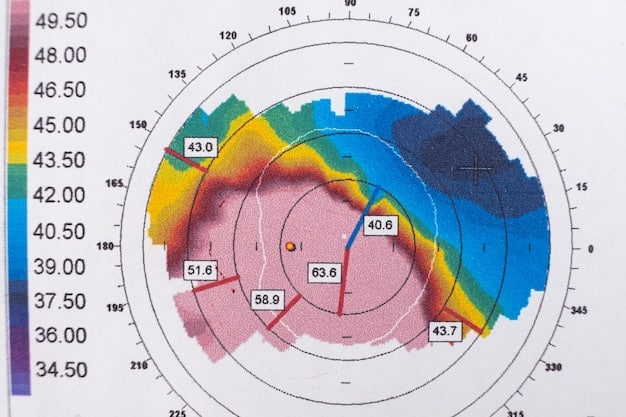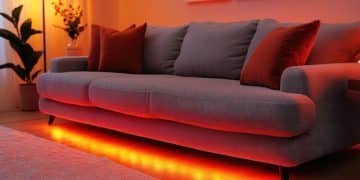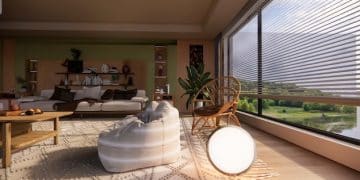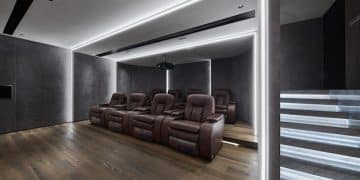Smart Lighting for Sleep: Optimize Your Home Lighting

Smart lighting can significantly improve sleep quality by regulating circadian rhythms through adjustable brightness, color temperature, and automated schedules that mimic natural light patterns.
Discover how smart lighting for better sleep: optimize your home’s lighting for improved sleep quality, transforming your home into a haven that promotes relaxation and enhances your natural sleep cycle.
Understanding the Impact of Light on Sleep
Light plays a crucial role in regulating our sleep-wake cycle, also known as our circadian rhythm. Understanding how different types of light affect our bodies can help us make informed decisions about our home lighting.
Our bodies are naturally synchronized with the rising and setting of the sun. Exposure to bright, blue-toned light during the day helps us stay alert, while darkness signals our bodies to produce melatonin, preparing us for sleep. However, artificial lighting and screens can disrupt this natural process.

The Circadian Rhythm and Light
- Melatonin Production: Light, especially blue light, suppresses melatonin production, which is essential for sleep.
- Daylight vs. Artificial Light: Daylight helps regulate our natural sleep-wake cycle, while artificial light at night can disrupt it.
- Timing is Key: Exposure to bright light in the evening can delay sleep onset.
Optimizing your exposure to light can significantly improve your sleep quality. Minimizing blue light exposure in the evening and maximizing natural light exposure during the day are key strategies.
Benefits of Smart Lighting for Sleep
Smart lighting for better sleep: optimize your home’s lighting for improved sleep quality offers a range of benefits that traditional lighting systems simply can’t match. From customizable settings to automated schedules, smart lighting can transform your sleep environment.
One of the biggest advantages of smart lighting is the ability to adjust the color temperature and brightness of your lights. This allows you to create an environment that is conducive to relaxation and sleep.
Customizable Settings
- Adjustable Color Temperature: Smart lights allow you to switch from cool, blue-toned light to warm, amber hues, which are less disruptive to sleep.
- Dimming Capabilities: Lowering the brightness of your lights in the evening signals your body to prepare for sleep.
- Automated Schedules: Set your lights to gradually dim and change color temperature as bedtime approaches.
By taking advantage of these features, you can create a personalized sleep environment that promotes relaxation and helps you fall asleep faster and stay asleep longer.
Choosing the Right Smart Lighting System
Selecting the right smart lighting for better sleep: optimize your home’s lighting for improved sleep quality system can be overwhelming with so many options available. Consider compatibility, features, and ease of use when making your decision.
There are several factors to consider when choosing a smart lighting system, including the type of bulbs, the control system, and the overall cost.

Factors to Consider
When it comes to choosing the right system, here are the key parameters:
- Type of Bulbs: LED bulbs are energy-efficient, long-lasting, and available with smart features.
- Compatibility: Ensure the system is compatible with your existing smart home ecosystem.
- Control System: Decide whether you want to control your lights with a smartphone app, voice assistant, or smart hub.
Careful planning and research can help you select a system that meets your needs and budget.
Setting Up Your Smart Lighting for Optimal Sleep
Once you’ve chosen your smart lighting for better sleep: optimize your home’s lighting for improved sleep quality system, the next step is to set it up for optimal sleep. Proper installation and configuration are essential for maximizing the benefits.
Start by replacing your existing bulbs with smart bulbs in your bedroom and any other areas where you spend time in the evening. Then, download the corresponding app and follow the instructions to connect your lights.
Installation and Configuration
Follow these steps for a great result:
- Replace Existing Bulbs: Swap out your old bulbs with smart LED bulbs.
- Download the App: Install the manufacturer’s app on your smartphone or tablet.
- Connect Your Lights: Follow the app’s instructions to connect your lights to your Wi-Fi network.
After connecting your lights, you can customize the settings to create your perfect sleep environment. Set up automated schedules, adjust the color temperature, and dim the lights as bedtime approaches.
Creating a Bedtime Routine with Smart Lighting
Establishing a consistent bedtime routine is crucial for improving sleep quality. Incorporating smart lighting for better sleep: optimize your home’s lighting for improved sleep quality into your routine can further enhance its effectiveness.
Start by setting your lights to gradually dim and shift to warmer color temperatures about two hours before bedtime. This signals your body to produce melatonin and prepare for sleep.
Evening Ambiance
Few tips worth to memorize:
- Gradual Dimming: Set your lights to gradually dim over a period of one to two hours before bedtime.
- Warm Color Temperatures: Shift to warmer, amber-hued light as bedtime approaches.
- Avoid Blue Light: Minimize exposure to blue light from screens and devices in the evening.
By creating a consistent and relaxing bedtime routine with smart lighting, you can significantly improve your sleep quality.
Troubleshooting Common Smart Lighting Issues
Even with the best smart lighting for better sleep: optimize your home’s lighting for improved sleep quality systems, you may encounter some issues. Troubleshooting common problems can help you maintain a consistent and effective sleep environment.
One of the most common issues with smart lighting is connectivity problems. If your lights are not responding, check your Wi-Fi connection and make sure your lights are properly connected to the network.
Connectivity and Other Issues
- Connectivity Problems: If your lights are not responding, check your Wi-Fi connection and ensure your lights are properly connected.
- Software Updates: Keep your smart lighting system’s software and firmware up to date to ensure optimal performance.
- Compatibility Issues: Some smart lighting systems may not be compatible with certain devices or platforms. Check compatibility before purchasing.
By addressing these common issues, you can maintain a seamless and effective smart lighting system that promotes better sleep.
| Key Point | Brief Description |
|---|---|
| 💡 Adjustable Light Color | Transition to a warm light, avoiding blue tones, particularly just before bed. |
| ⏰ Scheduled Dimming | Dim the lights automatically as bedtime approaches to get your body ready for sleep. |
| 📱 App Control | Control the intensity and color of the lights remotely, enhancing convenience. |
| 🌞 Maximize Daylight | Ensure you receive lots of natural light throughout the day to regulate your sleep patterns. |
Frequently Asked Questions
▼
Smart lighting helps regulate your circadian rhythm by mimicking natural light patterns, reducing blue light exposure in the evening, and promoting melatonin production.
▼
Warm, amber-toned light is ideal for sleep as it has a lower color temperature and does not suppress melatonin production as much as blue light.
▼
Yes, by creating a consistent bedtime routine and minimizing blue light exposure, smart lighting can help regulate sleep patterns, which may alleviate insomnia symptoms.
▼
While the initial investment may be higher, smart LED bulbs are energy-efficient and long-lasting, which can save you money on your energy bill in the long run.
▼
Yes, many smart lighting systems are compatible with voice assistants like Amazon Alexa and Google Assistant, allowing you to control your lights with voice commands.
Conclusion
Smart lighting for better sleep: optimize your home’s lighting for improved sleep quality offers a promising solution for enhancing your sleep environment. By understanding the impact of light on sleep, choosing the right smart lighting system, and incorporating it into your bedtime routine, you can create a personalized sleep environment that promotes relaxation and improves your overall sleep quality.





